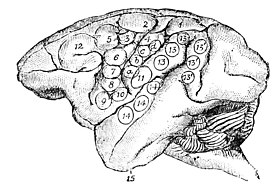the most interesting of these animals to us, from the striking resemblance between his brain and the human brain.
Hitzig's investigations, published in Berlin in 1874, give all the results gained up to that time by the stimulation experiments. Ferrier's book, "The Functions of the Brain," London, 1876, better known  Fig. 2.—Lateral Aspect of Monkey's Brain, showing the relative positions of the so-called "Motor Centers" in the left Cerebral Hemisphere. Ferrier. to English readers, has special merit in two respects. It displays a very intelligent comprehension of the consequences of electrical stimulation, and seems to give a juster account of the motor regions in the monkey's brain than was furnished by Hitzig.
Fig. 2.—Lateral Aspect of Monkey's Brain, showing the relative positions of the so-called "Motor Centers" in the left Cerebral Hemisphere. Ferrier. to English readers, has special merit in two respects. It displays a very intelligent comprehension of the consequences of electrical stimulation, and seems to give a juster account of the motor regions in the monkey's brain than was furnished by Hitzig.
Figs. 2 and 3 will show the character and results of these experiments in sufficient detail.
When center No. 1 is stimulated, the hind-limb on the opposite side of the body advances as in the act of walking; when No. 5 is stimulated, the opposite arm and hand reach forward as if to touch something. These movements go together and are essentially the  Fig. 3.—Upper Aspect of Monkey's Brain, showing the relative positions of some of the so-called "Motor Centers" in the left Cerebral Hemisphere, (Ferrier.) same. Centers 2 and 3 work together; when 2 is stimulated, there are combined movements of the opposite thigh, leg, and foot, and the foot is brought to the middle line of the body as in scratching that part, or in seizing something with the foot; 3 gives movements of the tail. An interesting fact should be noted at this point. There is no center No. 2 in the brain of cat, dog, or jackal, while No. 3 is present in each. These animals do not grasp with the foot, and the monkey alone uses the rear foot for seizing. That No. 2 should be present, and of great size, in the monkey's brain, while absent elsewhere, is confirmatory of the accuracy of the experiments. The centers marked a, b, c, d, are on the ascending parietal convolution. When stimulus is applied there, the fingers and wrist move with separate and combined movements
Fig. 3.—Upper Aspect of Monkey's Brain, showing the relative positions of some of the so-called "Motor Centers" in the left Cerebral Hemisphere, (Ferrier.) same. Centers 2 and 3 work together; when 2 is stimulated, there are combined movements of the opposite thigh, leg, and foot, and the foot is brought to the middle line of the body as in scratching that part, or in seizing something with the foot; 3 gives movements of the tail. An interesting fact should be noted at this point. There is no center No. 2 in the brain of cat, dog, or jackal, while No. 3 is present in each. These animals do not grasp with the foot, and the monkey alone uses the rear foot for seizing. That No. 2 should be present, and of great size, in the monkey's brain, while absent elsewhere, is confirmatory of the accuracy of the experiments. The centers marked a, b, c, d, are on the ascending parietal convolution. When stimulus is applied there, the fingers and wrist move with separate and combined movements
